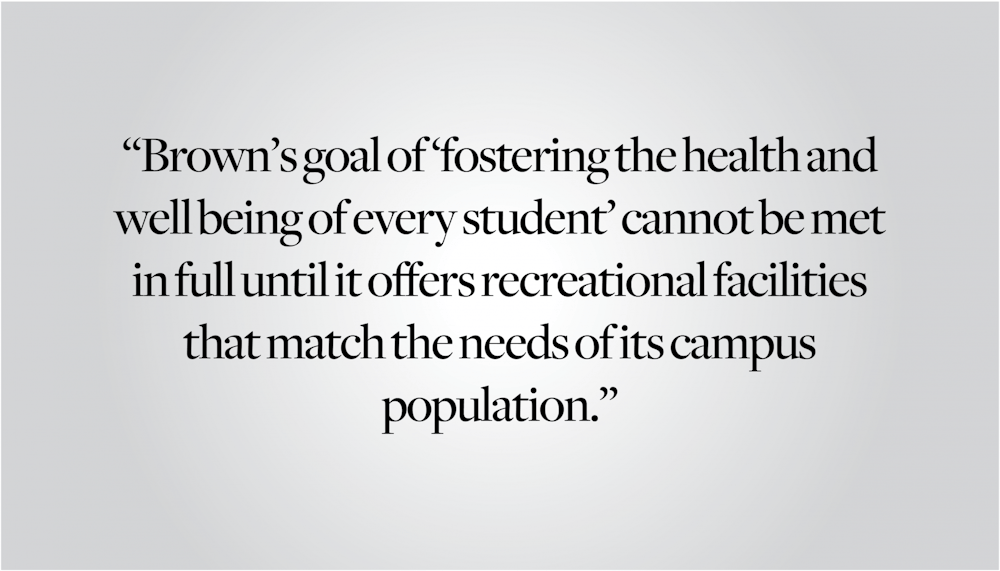If you have ever entered the Nelson Fitness Center’s loft, the following scene might sound familiar: You walk into the gym only to find every weight machine in use as students loiter to wait their turn. The free weight area is crammed with more people than there are workout mats to accommodate them and racks are stripped entirely of low and medium-weight dumbbells. The overcrowding and inaccessibility of basic equipment at the Nelson drew complaints from students early this semester that faded into the background as the weeks have gone by. But while the discourse fades, the problems at the Nelson have never really abated. As the undergraduate population at Brown “gradually expands,” the truth of the matter becomes unavoidable: We simply do not have enough gym space on campus. Beyond performatively voicing its commitment to student health, Brown needs to expand its recreational spaces and make fitness more accessible for its student population.
For a university of its size, Brown offers surprisingly few spaces on campus where students can consistently get a workout in: The 10,000-square-foot fitness loft in the Nelson Fitness Center, a gym in Graduate Center E that holds a handful of treadmills and ellipticals and a former gym space in Keeney Quadrangle, which now holds yoga classes. While Brown boasts a number of other facilities for athletics, many of these spaces are not available or intended for the general student population — or they’re sport-specific complexes that don’t contain basic equipment like treadmills and weights for day-to-day workouts.
The inadequacy of Brown’s fitness options for its 7,125 undergraduates and 2,689 graduate students becomes particularly evident when compared to the recreational facilities offered by other institutions. Take Colby College, a liberal arts college that offers three floors of weight training and cardio equipment in its Boulos Family Fitness Center for an undergraduate population of just over 2,200 — well under half of Brown’s. Likewise, Dartmouth’s 16,000-square-foot Zimmerman Fitness Center offers over 100 machines and three different dumbbell areas. And Penn’s facilities supplement an 8,000-square-foot weight room with a 40-foot climbing wall and two more floors of weights and cardio equipment. Brown isn’t up to the standard of its peers on an issue that goes beyond working out alone: Regular exercise helps college students manage sleep, stress and overall mental health. Brown’s goal of “fostering the health and well-being of every student” cannot be met in full until it offers recreational facilities that match the needs of its campus population.
Some initiatives to address the overcrowding at the Nelson are already underway. In response to student complaints at the beginning of the spring semester, the Undergraduate Council of Students worked with administrators to introduce an occupancy tracker. A March 24 UCS email also announced a pilot program to extend Fitness Loft hours through 11 p.m. from Mondays to Thursdays, with the hopes of eventually keeping the gym open until midnight. But while promising, these solutions show the incomplete scope of UCS’s power to improve overcrowding, an administrative-level issue that has more to do with space than time. Students shouldn't have to micromanage their schedules and check an app in order to work out. Nor should they have to wait until 10:30 p.m. to hope for a chance at using a squat rack. Exercise should be about relieving stress instead of causing it through complicated planning. Brown’s fitness and wellness manager has noted that Brown Recreation is “exploring existing spaces within the Nelson Fitness Center to create additional opportunities for training.” But there are no concrete public plans to initiate a large-scale expansion or to introduce new fitness options in other areas around campus.
Reopening the Keeney Quad gym as a yoga studio is also a well-intentioned but misinformed step to make fitness more accessible on campus. Although having a dedicated location for yoga is admirable, it should not come at the expense of a broader, multi-use facility in an area of campus that currently lacks one. Yoga requires space but little equipment, meaning there are multiple places — such as the multipurpose room in Sternlicht Commons — where classes could be held on a more regular basis. On the other hand, the Keeney Quad gym is one of the few locations where heavier equipment could be stored and used permanently.
The changes at the Nelson might shift surface-level conditions, but not the underlying issues concerning the amount of space and equipment available. Brown is dancing around the solution that will produce lasting improvements: opening new fitness spaces on a campus that sorely needs them. This might entail converting existing properties or building an entirely new facility altogether, neither of which would be an easy task. Brown would have to embrace the costly, difficult and time-intensive project of renovating or acquiring new space. But the expenditure is certainly worth it. After Purdue University spent $98 million on expanding and renovating its recreation center, use of the facilities increased and many students saw improved academic performance. If Brown made a similar investment, it could see a similar increase in the number of students who choose to use its gyms and make fitness a regular part of their routine. A major investment in recreational space and resources would represent a major investment in the health and well-being of Brown students — one that is long overdue.
Editorials are written by The Herald’s editorial page board and aim to contribute informed opinions to campus debates while remaining mindful of the group’s past stances. The editorial page board and its views are separate from The Herald’s newsroom and the 133rd Editorial Board, which leads the paper. This editorial was written by the editorial page board’s editor Kate Waisel ’24 and members Irene Chou ’23, Yasmeen Gaber ’23, Tom Li ’26, Jackson McGough ’23, Alissa Simon ’25 and Yael Wellisch ’26.





